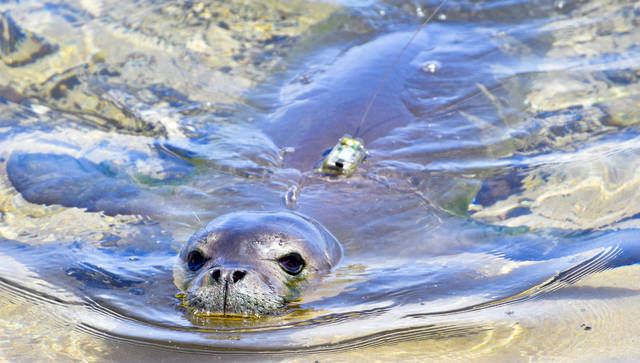KAPAA — The young seal removed from Lihi Canal in Kapaa has returned after being relocated to the Westside late last month, and experts aren’t going to move the seal again. That’s because the seal, RH92, has found a steady
KAPAA — The young seal removed from Lihi Canal in Kapaa has returned after being relocated to the Westside late last month, and experts aren’t going to move the seal again.
That’s because the seal, RH92, has found a steady stream of discarded fish scraps and is returning to the area for an easy meal, said Jamie Thompton, Kauai Marine Mammal Response Program Coordinator for the National Oceanic and Atmospheric Administration.
“Given that the initial relocation effort was unsuccessful, past experience leads staff biologists to believe that RH92 will continue to be drawn to a known, easily accessible food — discarded fish scraps,” he said. “A second relocation would be unlikely to result in a different outcome.”
The 10-month-old seal was removed from the canal on March 30 by wildlife biologists and veterinarians.
It was feeding on small fish in the waterway and discarded fish parts, according to a news release from the state’s Department of Land and Natural Resources.
“Any time you attract a wild animal into an area where human use is high, you’re increasing the risk of interaction between people and the seal,” Thompton said. “You’re also exposing the seal to more risks, such as fishing nets that might be in the water, fishing hooks or strikes by boats.”
Monk seals frequently explore inland fresh waterways like streams and rivers, and discarded fish scraps tend to attract them, especially the young seals. In fact, two seals have been found dead in the Lihi Canal over the past two-and-a-half years and it’s believed they drowned, possibly after getting entangled in fishnets.
The two seals that apparently drowned previously in the canal were RG13, a yearling female found dead on March 14, 2016, and R4DD, a juvenile male found dead on Aug. 22, 2014.
Necropsies (animal autopsies) conducted on each animal showed them to be in overall good health, but had lung damage consistent with drowning.
RH92 was born to seal RK22 on May 23, 2016, at Larsen’s Beach on Kauai’s North Shore. She stayed in that area until the end of 2016. So far this year she’s been spotted on the eastern side of the island starting in early March.
“The last thing we want is to lose RH92, because she’s come back to Lihi, for the easy food of discarded fish guts, heads, and tails,” Thompton said.
Hawaiian monk seals don’t eat fish like ono, ahi and mahi mahi, according to DLNR. Instead they feed mostly on small reef fish, tako (octopus) and lobsters.
“Top predators like seals and sharks help keep reef fish populations healthy, because just like wolves on the land, they pick out the sick and injured fish to feed on,” said Mimi Olry of DLNR’s Department of Aquatic Resources.
Dropping unused bait and fish parts into the water is illegal. Officers from the DLNR Division of Conservation and Resources Enforcement are increasing their patrols at Lihi.
The goal is to educate captains, crews and fishermen about the consequences of dropping fish parts into the water, which is the other reason experts are leaving the seal alone.
“Continuing to move the seal would also fail to address the root of the problem — the combination of an easy food source and entanglement hazards in the form of illegal nets,” Thompton said
If one-on-one education doesn’t work, DOCARE officers may begin writing citations for littering.


